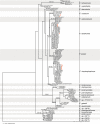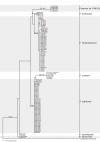Fusarium species isolated from post-hatchling loggerhead sea turtles (Caretta caretta) in South Africa
- PMID: 35393437
- PMCID: PMC8991248
- DOI: 10.1038/s41598-022-06840-1
Fusarium species isolated from post-hatchling loggerhead sea turtles (Caretta caretta) in South Africa
Erratum in
-
Publisher Correction: Fusarium species isolated from post-hatchling loggerhead sea turtles (Caretta caretta) in South Africa.Sci Rep. 2022 May 27;12(1):8951. doi: 10.1038/s41598-022-12820-2. Sci Rep. 2022. PMID: 35624137 Free PMC article. No abstract available.
Abstract
Species in the Fusarium solani species complex are fast growing, environmental saprophytic fungi. Members of this genus are filamentous fungi with a wide geographical distribution. Fusarium keratoplasticum and F. falciforme have previously been isolated from sea turtle nests and have been associated with high egg mortality rates. Skin lesions were observed in a number of stranded, post-hatchling loggerhead sea turtles (Caretta caretta) in a rehabilitation facility in South Africa. Fungal hyphae were observed in epidermal scrapes of affected turtles and were isolated. The aim of this study was to characterise the Fusarium species that were isolated from these post-hatchling loggerhead sea turtles (Caretta caretta) that washed up on beaches along the South African coastline. Three gene regions were amplified and sequenced, namely the internal transcribed spacer region (ITS), a part of the nuclear large subunit (LSU), and part of the translation elongation factor 1 α (tef1) gene region. Molecular characteristics of strains isolated during this study showed high similarity with Fusarium isolates, which have previously been associated with high egg mortality rates in loggerhead sea turtles. This is the first record of F. keratoplasticum, F. falciforme and F. crassum isolated from stranded post-hatchling loggerhead sea turtles in South Africa.
© 2022. The Author(s).
Conflict of interest statement
The authors declare no competing interests.
Figures




Similar articles
-
Fusarium spp. in Loggerhead Sea Turtles (Caretta caretta): From Colonization to Infection.Vet Pathol. 2020 Jan;57(1):139-146. doi: 10.1177/0300985819880347. Epub 2019 Oct 29. Vet Pathol. 2020. PMID: 31662046
-
[Clusters of Fusarium solani infection in juvenile captive born Caretta caretta sea turtles].J Mycol Med. 2017 Mar;27(1):113-118. doi: 10.1016/j.mycmed.2016.12.001. Epub 2016 Dec 30. J Mycol Med. 2017. PMID: 28043787 French.
-
First data on microflora of loggerhead sea turtle (Caretta caretta) nests from the coastlines of Sicily.Biol Open. 2020 Jan 29;9(1):bio045252. doi: 10.1242/bio.045252. Biol Open. 2020. PMID: 31915211 Free PMC article.
-
Lesions Observed Post Mortem in Post-hatchling Loggerhead Sea Turtles (Caretta caretta) from a Head Start Programme.J Comp Pathol. 2020 Jan;174:73-80. doi: 10.1016/j.jcpa.2019.11.001. Epub 2019 Dec 9. J Comp Pathol. 2020. PMID: 31955806
-
Newly emerging diseases of marine turtles, especially sea turtle egg fusariosis (SEFT), caused by species in the Fusarium solani complex (FSSC).Mycology. 2020 Jan 7;11(3):184-194. doi: 10.1080/21501203.2019.1710303. Mycology. 2020. PMID: 33062381 Free PMC article. Review.
Cited by
-
Fungal Diseases in Elasmobranchs and Their Possible Treatment with a Special Mention to Azole Antifungal Agents.Animals (Basel). 2023 Dec 21;14(1):43. doi: 10.3390/ani14010043. Animals (Basel). 2023. PMID: 38200774 Free PMC article. Review.
-
Voriconazole Pharmacokinetics Administered at 4 mg/kg IM and IV in Nursehound Sharks (Scyliorhinus stellaris) Under Human Care.Vet Sci. 2025 Jan 3;12(1):17. doi: 10.3390/vetsci12010017. Vet Sci. 2025. PMID: 39852892 Free PMC article.
-
Mycotic Diseases in Chelonians.J Fungi (Basel). 2023 Apr 27;9(5):518. doi: 10.3390/jof9050518. J Fungi (Basel). 2023. PMID: 37233230 Free PMC article. Review.
-
Pharmacokinetic study of voriconazole administered orally at 50 mg/kg in nursehound sharks (Scyliorhinus stellaris) and udulate skates (Raja undulata).BMC Vet Res. 2025 Jul 23;21(1):484. doi: 10.1186/s12917-025-04930-6. BMC Vet Res. 2025. PMID: 40702510 Free PMC article.
References
-
- O’Donnell K. Molecular phylogeny of the Nectria haematococca-Fusarium solani species complex. Mycologia. 2000;92:919–938. doi: 10.1080/00275514.2000.12061237. - DOI
Publication types
MeSH terms
LinkOut - more resources
Full Text Sources

